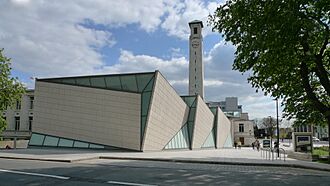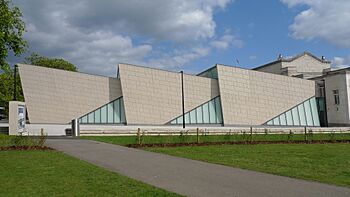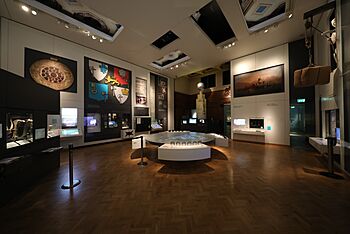SeaCity Museum facts for kids
Quick facts for kids SeaCity Museum |
|
|---|---|

SeaCity Museum, viewed from the North. The pavilion is in the foreground.
|
|
| General information | |
| Location | Southampton, United Kingdom |
| Coordinates | 50°54′29″N 1°24′28″W / 50.908021°N 1.407664°W |
| Opened | 10 April 2012 |
| Cost | £15,000,000 |
| Design and construction | |
| Architect | Wilkinson Eyre (refurbishment and extension) E. Berry Webber (original building) |
| Main contractor | Kier Southern |
The SeaCity Museum is a cool museum in Southampton, England. It opened on April 10, 2012. This date was special because it was exactly 100 years since the famous ship RMS Titanic left Southampton.
The museum is inside a historic building called the Civic Centre. This building used to be a court and a police station. SeaCity Museum has two main exhibits that are always there. One is all about Southampton's link to the Titanic. The other shows how Southampton has been a major port, connecting people to the rest of the world. There's also a special area for temporary exhibits. This part is in a new building called the pavilion, which was built just for the museum.
The museum was designed by a company called Wilkinson Eyre. The main builders were Kier Southern. The whole project cost £15 million. About £5 million came from the Heritage Lottery Fund. The rest of the money came from Southampton City Council and a group called the Southampton Cultural Development Trust.
Contents
How the Museum Started
Plans for a new history center in Southampton began way back in 2002. The city council wanted to find the best way to tell Southampton's story. They looked at a few different places for the museum.
- Lower High Street
- Mayflower Park
- Berth 101 at the Port of Southampton
- The old Vosper Thornycroft shipyard in Woolston
But all these places were too expensive or difficult to use. Then, in 2006, the Southampton Police decided to move out of the Civic Centre. The court had already left in 2001. This meant a whole part of the Civic Centre building would be empty. So, the Civic Centre became the top choice for the new museum by 2007.
New plans for the Civic Centre museum were shared in 2008. The first ideas included a big, three-story addition to the building. They also thought about adding a water feature from a nearby park. But these ideas were too expensive. So, they were removed to save about £10 million.
The project was then split into two parts. The first part would focus on Southampton's connection to the Titanic. This is when the name "SeaCity" was first used. This first phase had a budget of £15 million. It was planned to be finished in 2012, just in time for the Titanic anniversary.
Funding the Museum
Southampton City Council asked the Heritage Lottery Fund for money. They received £0.5 million in 2009 to help plan the museum. Then, in 2010, they got another £4.6 million to help with building it.
To get the rest of the £15 million, the city council thought about selling some artworks from their city art collection in 2009. They believed these artworks didn't fit with the gallery's main focus. Also, the art gallery only had space to show 200 of its 3,500 artworks at one time. The council hoped selling two pieces would raise £5 million. This money would help display 100 more artworks in the new museum.
Some people in the city supported selling the art. But many others were against it. They said it would be a "betrayal of public trust." They worried it would harm the city's museum reputation. They also thought it might stop people from donating art in the future. Some politicians suggested borrowing money instead of selling the art. But the council leaders at the time said that would mean cutting other important services or raising taxes.
People who were against the sale formed a group called "Save our Collection." They protested and collected over 2,500 signatures on a petition. Experts also warned that selling the art would damage the gallery's standing. It would also go against the rules for museums.
Because of all the strong opposition, Southampton City Council paused the art sale in November 2009. By February 2010, they completely canceled the plan. The council found other ways to get money. They looked at selling other city properties that were now worth more. They also explored working with nearby councils to share artworks. If there was still a gap in funding, they said they would borrow the money.
A charity called the Southampton Cultural Development Trust was created in 2010 to help raise funds. The museum also received grants from other groups. These included the Department for Culture, Media and Sport (with the Wolfson Foundation) and the Garfield Weston Foundation.
Building the Museum
Southampton City Council chose the design team in July 2009. Wilkinson Eyre was the main designer. A year later, Kier Southern was chosen as the main builder. Even though some people had doubts about how the new pavilion would look, it was approved. Final building permission was given in September 2010. Work started in October.
There were some challenges during construction. Builders found a lot of rust on the original building's steel frame. This had to be fixed. It was also tricky to add the necessary security for museum exhibits inside a historic building. But some parts of the old building were kept. For example, the former prison cells were turned into restrooms. An old court room was kept as an exhibit space.
By August 2011, the pavilion building was finished. A special ceremony was held to celebrate. The pavilion was designed with three connected sections. This helped it fit onto the uneven land, which sloped two meters from south to north. The outside of the pavilion uses stone that matches the original Civic Centre building. Wilkinson Eyre described the pavilion as a "bold architectural addition." They said it showed that a "new important cultural attraction" was in the city.
The completed museum offers 2,000 square meters of space for exhibits and learning. The museum opened on time on April 10, 2012. This was a perfect way to mark 100 years since the RMS Titanic left Southampton.
The work on SeaCity Museum received praise from building experts. The Institution of Structural Engineers nominated the structural design for an award in 2012. Architects' Journal also nominated the designers and builders for awards.
Museum Exhibits
SeaCity Museum has three main exhibitions. All of them were designed by a company called Urban Salon. Two permanent exhibits are in the parts of the building that used to be the police station and the court.
- Gateway to the World looks at Southampton's long history. It shows how the city has been a key place for people moving around the world. One cool exhibit is a huge, one-ton, seven-meter-long model of the RMS Queen Mary ship. This model used to be in the Southampton Maritime Museum. Both the Southampton Maritime Museum and the Southampton Museum of Archaeology closed in September 2011. Their exhibits were moved to SeaCity and Tudor House Museum.
- Southampton's Titanic Story tells the sad tale of the Titanic sinking. It focuses on the ship's crew, most of whom lived in Southampton. In a preserved court room, visitors can watch and listen to scenes from the official investigation into the sinking. They can learn about what happened next. As you enter this exhibit, you can see the Civic Centre clock tower through a roof window. This tower is about the same height as a Titanic funnel. This helps visitors understand how huge the ship was. The exhibit also includes real audio recordings from survivors. There are interactive parts where you can pretend to steer the virtual ship or stoke its engines.
The pavilion building is used for temporary exhibits. The very first one, for the Titanic anniversary, was called Titanic: The Legend. It explored why people are still so fascinated by the ship. It showed how the Titanic has been shown in movies and books. The exhibit had screens playing scenes from films like the 1912 movie In Nacht und Eis and the 1997 movie Titanic. It also displayed many Titanic souvenirs. These included special "mourning bears" and jigsaw puzzles.
Experts have praised the museum. One reviewer said comparing the Civic Centre's height to the Titanic's height was a great idea. They also liked how the graphics made the story easy for everyone to understand. Another reviewer said the new building was much better than the old museum. They liked how the museum used videos and sounds in a smart way. They hoped that the museum would continue to grow and add more exhibits in the future.
Southampton City Council thought the museum would get over 150,000 visitors each year. But these numbers were only reached in the first year. After that, the number of visitors went down. This has raised some concerns about how the museum will be funded in the long term.
Images for kids






